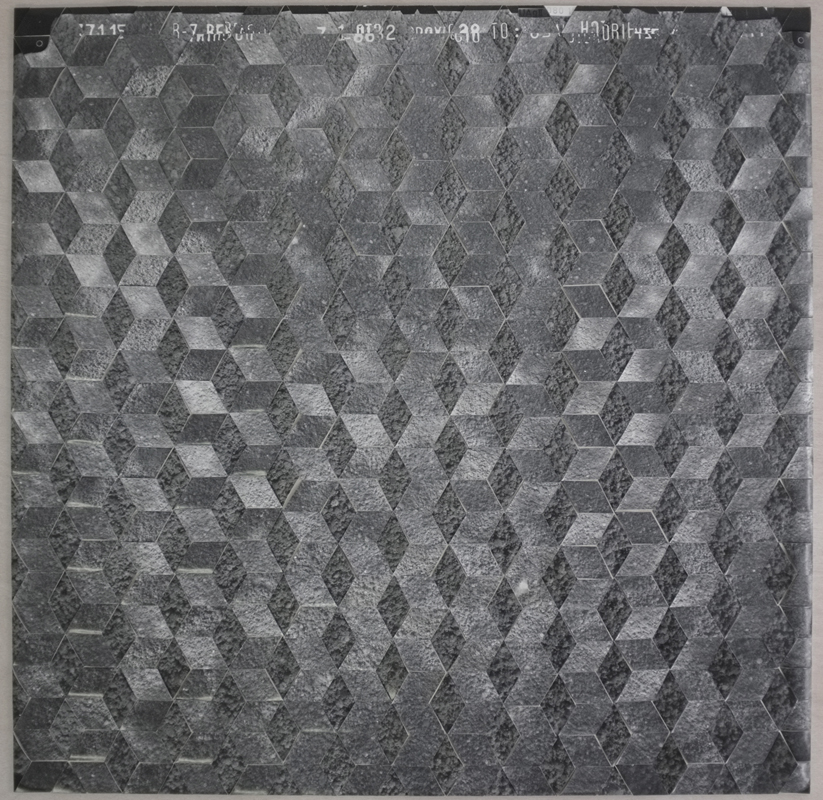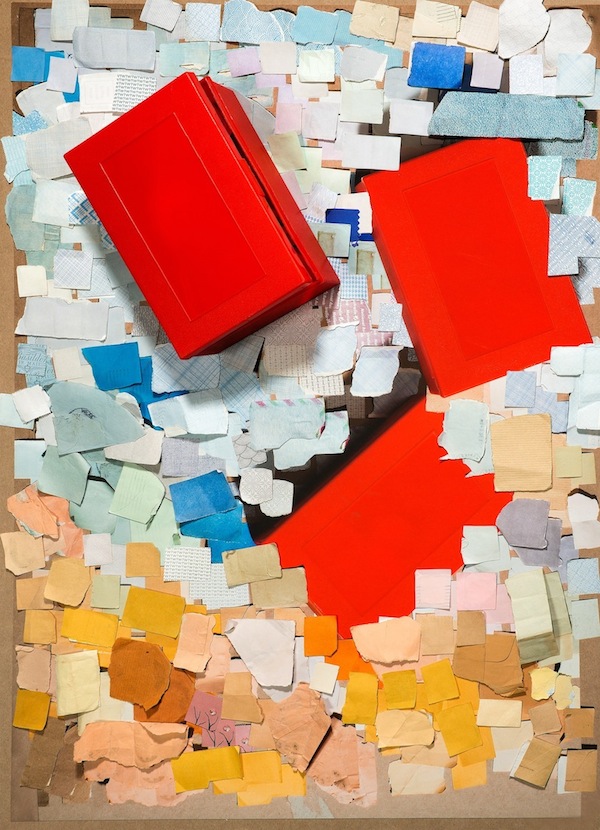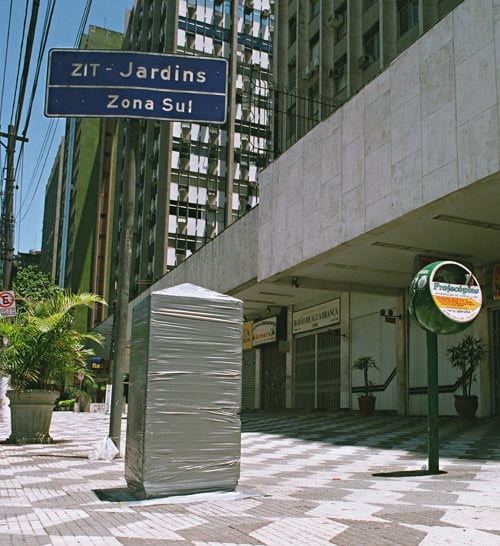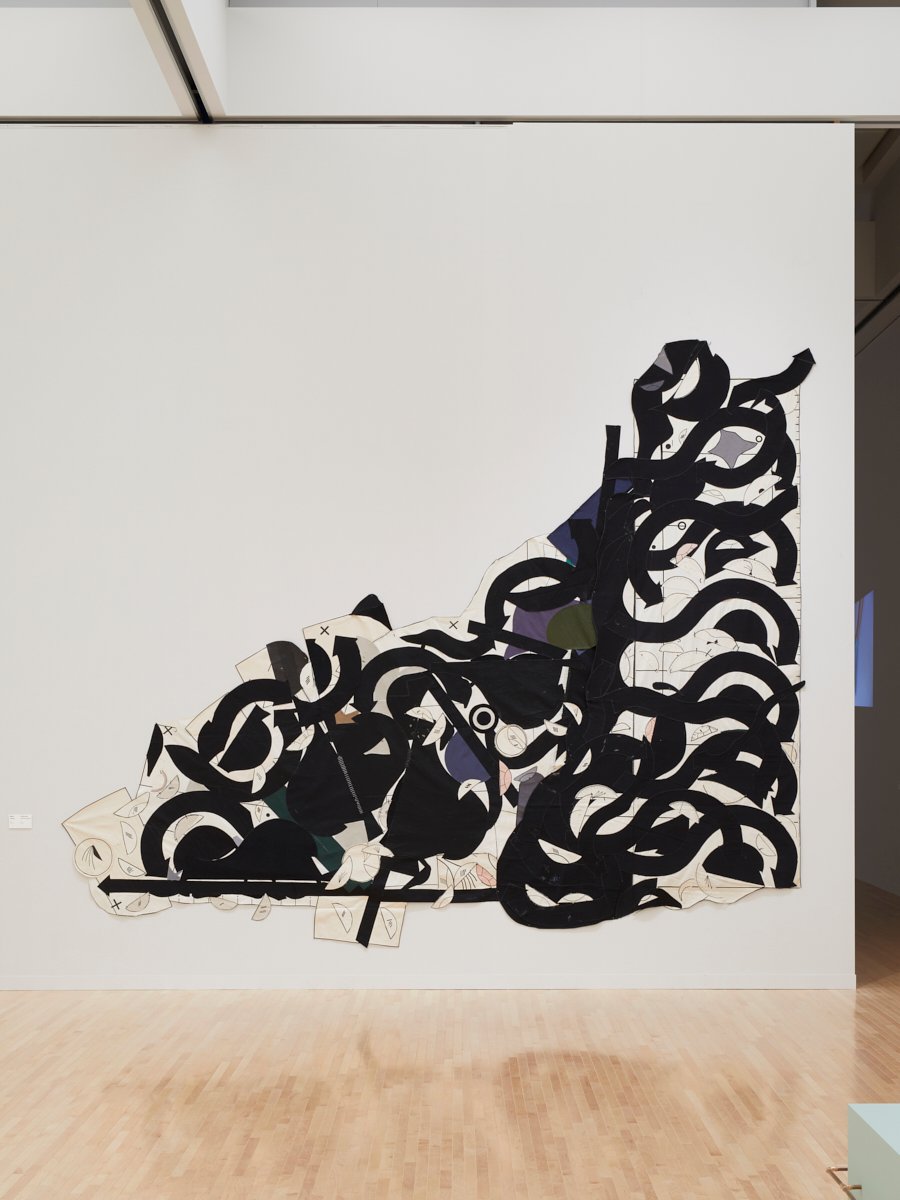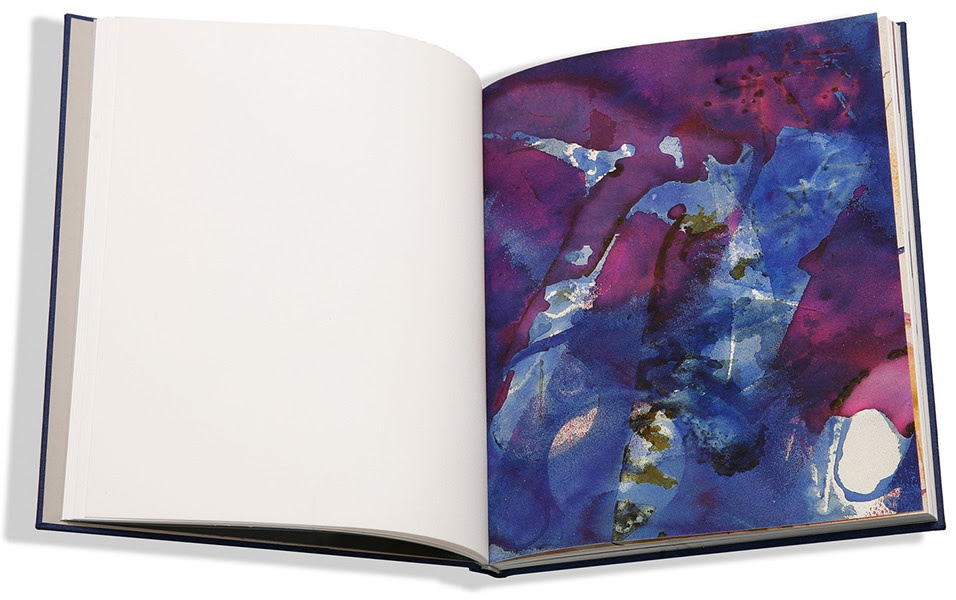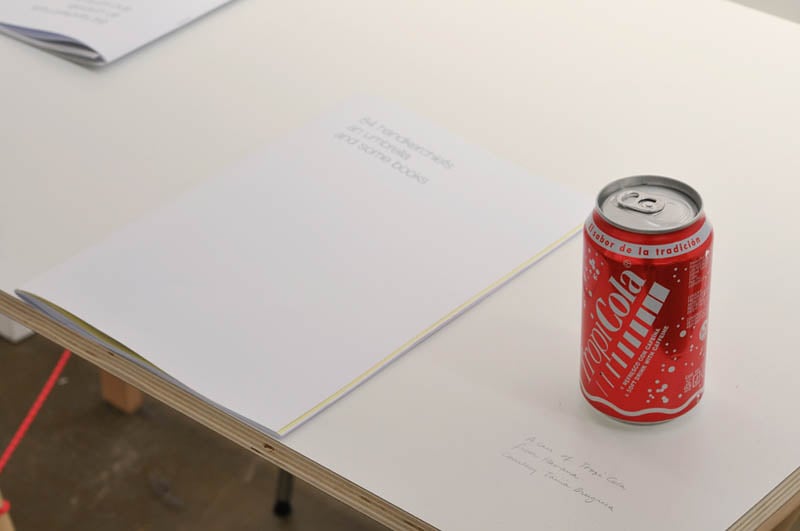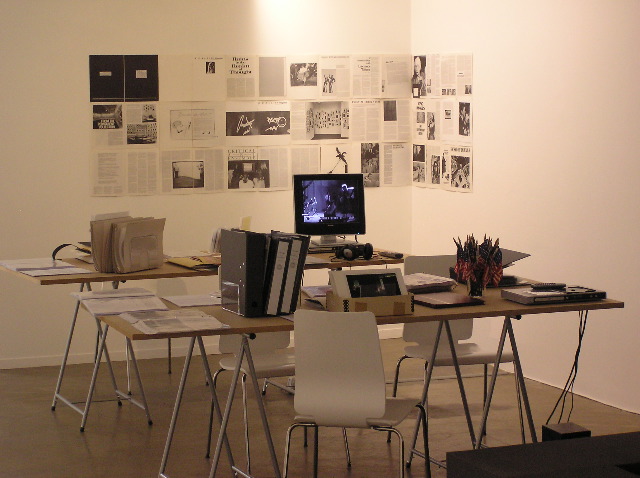
© » KADIST
American Artist
From suicides, to gang violence, to the epidemic abuse of force by police departments (predominantly against Black men), to school and mass shootings, there is perhaps no more urgent issue in the United States than gun control. The color blue is a proxy for both sadness, and a color that is emblematic of American law enforcement services. I Am Blue, 1 by American Artist is a sculpture that fuses a school desk with a ballistic shield.

© » KADIST
Sable Elyse Smith
Sable Elyse Smith’s Pivot III resembles playground equipment uselessly reconfigured. The stainless-steel asterisks, assembled from prison visitation-room seating, are painted 2K black and blue: colors evoking the US criminal justice system, its racist enforcement, and the heavy-duty finish of finance capitalism with which the culture industry is enmeshed. The work consists of six long rods, affixed via plate to each of the faces of a central cube, from which they radiate in perfect symmetry.

© » KADIST
Cynthia Gutiérrez
Estratos II by artist Cynthia Gutiérrez features a large white plinth with a transversal cut through the lower half, revealing a collection of archeological objects. These pieces of history have seemingly been lost to time and have lived covered under a sterile exterior. To create the ceramic objects for this project, Gutiérrez worked closely with an artist that creates Mesoamerican replicas.

© » KADIST
Rometti Costales
Canción para un fósil canoro (Song for a chanting fossil) by Rometti Costales is inspired by the history of the building that currently hosts the Museo de la Solidaridad Salvador Allende (MSSA) in Santiago, Chile. The duo associated the layers of the building’s history with the vestiges of life and the processes of fossilization that have taken place in areas of the Atacama Desert, a territory that has been the stage for several episodes in Chile’s tumultuous economic and political history. The work operates as a metaphor for the strata of historical memory, condensing different materials and operations.

© » KADIST
Marina Rosenfeld
The installation Music Stands: Free Exercise 7, 8, and 9 by Marina Rosenfeld consists of music stand-like structures and a corresponding set of panels and acoustic devices that direct, focus, obstruct, reflect and project sound in the gallery. Together the components play on the connection between aural and social relations signified by the music stands. An episodic score emanates from the work’s sound system, momentarily interrupting the atmosphere with brief eruptions of electronic sounds and vocality.

© » KADIST
Tromarama
The installation Soliloquy by Tromarama features 96 second-hand lamps scattered around the space like islands or entities left in solitude. Each time the hashtag “#kinship” is used on Twitter, the tweet is converted into binary code, which triggers their switches and creates a symphony of lights. The flashing bulbs transcribe layers of human desire and of individual stories that manifest users’ connections forged across physical and digital realms.
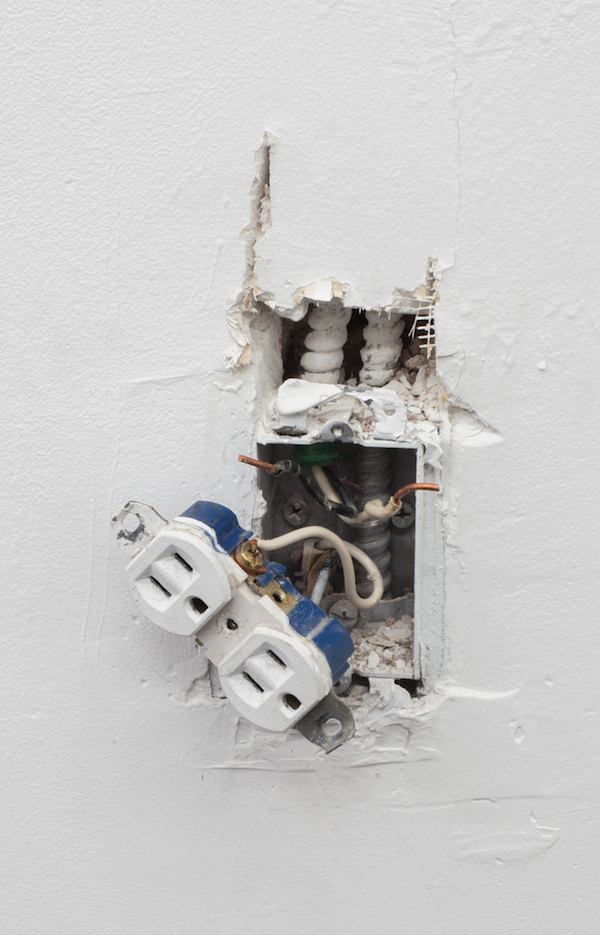
© » KADIST
Cameron Rowland
Rowland’s minimal installations require a focus not on the objects themselves, but on the conditions of their creation, use, and distribution. Who controls the services that contemporary citizens take for granted—like power, water, heat? Who makes these objects that deliver these services?

© » KADIST
Jiri Kovanda
This ephemeral installation by Jirí Kovanda, documented in the same way as his performances with a photograph and a text, belongs to a body of works that took place in his apartment/studio. During an interview with Hans Ulrich Obrist, the artist highlighted that he had never had a studio and that this work space blended with his apartment. A piece of string cuts across the room in a diagonal; it functions as a scale to measure time and space.

© » KADIST
Taiyo Kimura
Haunted by You documents Taiyo Kimura’s struggle to use a record player, satirizing the normal actions of everyday life in order to question the meanings that underlie ordinary modes of living. The performance narrative unfolds upon the circular movements of the turntable. A chicken’s leg replaces the turntable’s arm.

© » KADIST
Vaclav Pozarek
Concerning his objects, Pozarek often relies on chance to guide him. He uses scraps of wood, boxes, hinges and doors, keeping a close eye on what position each object will assume later in the space. Although it suggests the opposite at first glance, Zwillinge is autonomous and functionless.

© » KADIST
Frieda Toranzo Jaeger
This triptych is based on a Tesla whose interior the artist customized on the Tesla website. The width of the work when the panels are closed is the exact width of a Tesla, thus one designed to hold two bodies side by side. In Mexico City the car is used as a social space and, for young people, one not controlled by parents.

© » KADIST
Mélanie Matranga
My Shape (2018) is the final work of the exhibition “Sorry”, taking the form of a Levi’s denim jacket pattern, expanded three or four times larger than its original shape. Adorned with different pockets, visible through the transparency of the paper and different light bulbs illuminating the form, white cables link the piece to hidden plug sockets, recalling a similar piece made by the artist for the 2015 Ricard Foundation prize. The work is representative of a series of recurrent concepts in the artist’s work manipulation of scale, abstraction through monumentalization, highlighting of tangential objects integrated like sculptural elements by the artist, in a way in which others might try and hide them, as well as the melding of the intimate alongside objects of mass production and the globalization of tastes.
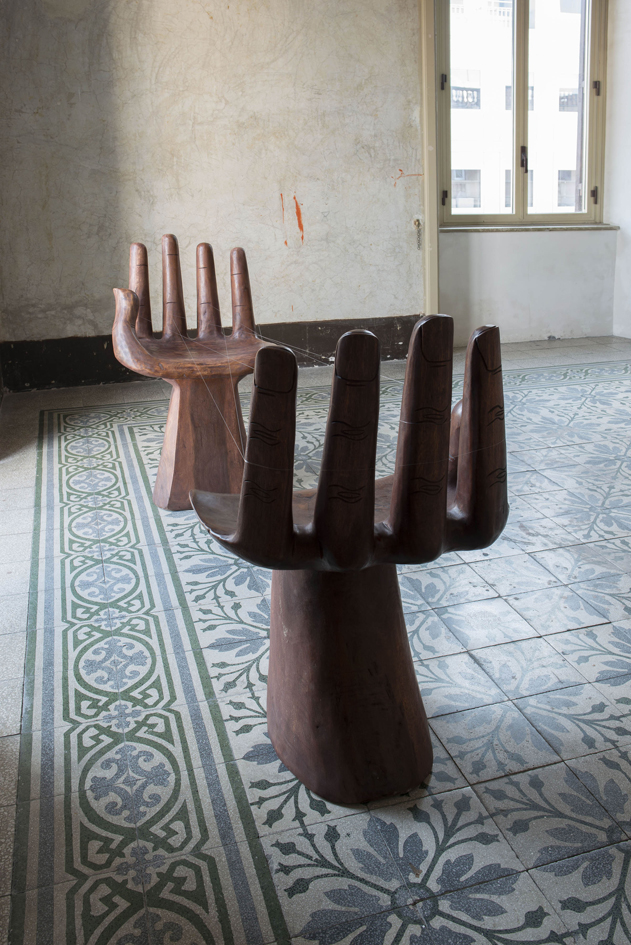
© » KADIST
Adriana Lara
Lara uses things readily at hand to create objects and situations that interrogate the processes of art and the spectrum of roles that art and artists play in society. To these ends, she has used furniture, projections, photographs, clothing, and even people as her materials. A reflection on how the production of meaning itself takes place in the manufacturing of things is embodied in wooden hand chairs, a crafty Indonesian version of the iconic Pedro Friedeberg 1960s Pop design.

© » KADIST
Benoît Maire
The piece consists of sculpture of 10 elements, among them: a globe, a picture of a gorilla, a chair, scrabble letters, 3 glasses of black ink, a book whose title is illuminated by the beam of a 8mm projector, a pair of boots, etc. The display is a collection of selected objects chosen in response to the reading of a text by Alain Badiou (the first chapter of the seminar “Le réel est l’impasse de la formalisation; la formalisation est le lieu de passe en force du réel” from February 4, 1975). The elements are a visual way to question the transposition of an idea into reality.

© » KADIST
Yuji Agematsu
Each day, Yuji Agematsu smokes a pack of cigarettes and wanders the streets of New York City looking for trash. Needless to say, he finds it everywhere: bottle caps, gummed hair, translucent miscellany, sick feathers, hot pink plastics, unknown, and more. The varied bits are then constellated by the artist in cellophane cigarette wrappers—modest vitrines for his steady collecting habit.

© » KADIST
John Menick
The theme of the end of the world, of the last man on earth, recurs in our literary and cinematographic culture and in our imaginary: “we had this dream before, the dream that we’re alone.” In The Secret Life of Things , the narrator presents himself as an enthusiast and expert on films announcing the end of the world and those staging someone waking up to discover that they are the only survivor on earth. Like in some works by Mario Garcia Torres (like The Transparencies of the Non-Act , a slide projection about the artist Oscar Neuestern, Kadist Collection), the artist lends his discourse to a stranger. Mastering the montage, he intersperses a monologue and images.

© » KADIST
Pratchaya Phinthong
Untitled (Ring) consists of two prominent elements contained in water filled glass sphere. The first, Phinthong’s wife’s ring, cast in recycled gold, collected from damaged electronic devices during Thailand’s great flood in late 2011. It is intended to be a reminder of when the couple consoled one another amid the flooding disaster.

© » KADIST
Matt Mullican
Drawing & Print (Drawing & Print)
Mullican’s Stick Figure Drawings depict characters reduced to their most basic graphic representation. Glen is a simple silhouette, genderless and inspired by a found photo of a crime scene, in whom we recognize the generic sign of the universal symbol of a self-portrait. Mullican continually projects himself, sometimes physically, into the silhouette that he has created, allowing the artist to pass from one reality to another.

© » KADIST
Oscar Tuazon
Oscar Tuazon‘s sculptural oeuvre is situated at the border of art, architecture and technology. Engaging different methods of construction, he frequently uses wood, concrete, glass, steel, and piping as materials to create his structures and installations. Tuazon’s works have roots in minimalism, conceptualism, and architecture, and have a direct relationship with both the site in which they are presented, as well as with their viewer, often through physical engagement.

© » KADIST
Oren Pinhassi
Oren Pinhassi’s work examines the relationship between the human figure and the built environment. His hybrid sculptures, often somewhat emaciated, hover between the figurative and the architectural. In the case of The Crowd , a series of sculptures which evince architectures of control – where humans act and exert power – we find voting booths, segregation cells, institutional desks, places where bureaucratic exchange become spaces of bodily desire, complete with sexual appendages.

© » KADIST
Dineo Seshee Bopape
Interested in the collection of object and their potential to evoke various emotional reactions in the audience, Bopape’s “Why do you call me when you know I can’t answer the phone” is an invitation into the limitless netherworld of the unsaid and unspoken. Exploring the metaphysical landscape of secrets, lies and psychosexual ambivalence, this work is an attempt to create a site for contemplation. The video ventures to provoke a rhythmic trance through transporting the mind into a distant illusionary world constructed by vignettes of fractured spaces.

© » KADIST
Marlon de Azambuja
Following a series of related works, Brutalismo Americano by Marlon de Azambuja is a site-specific sculptural installation produced during the artist’s residency at Kadist, San Francisco in 2017. Treating the city as an object of attention, de Azambuja collected building materials from the surrounding area over a period of ten days to conceive of an architecture in situ. The work is not meant to mimic any of San Francisco’s own architecture, or to be a maquette or portrait of the cityscape, but instead a singular, constructive gesture.

© » KADIST
Alejandro Almanza Pereda
This still life falls apart, or rather floats apart as the composition is proved unstable and constantly morphing. An impossible attempt at achieving a fixed state, some objects remain buoyant and some objects sink, constantly tilting the overall scale and arrangement. Properties of weight, mass and shape have their own will but a hand appears in the scene, pushing back on these mysterious forces.

© » KADIST
Orion Shepherd
Drawing & Print (Drawing & Print)
Ballad of the Unabomber Part I is a painting by Orion Shepherd that features several manila folders stacked in order according to their size, resting atop a grainy hardwood pattern. The painting refers to Theodore John Kaczynski, most commonly known as the Unabomber, and depicts the seemingly innocuous manila envelopes, which through his hands became fatal explosive weapons. Despite the deplorable actions that earned Kaczynski a life sentence, the manifesto that he demanded to be published has been regarded by many as a sane and highly intelligent work, correct in several of his ideas.
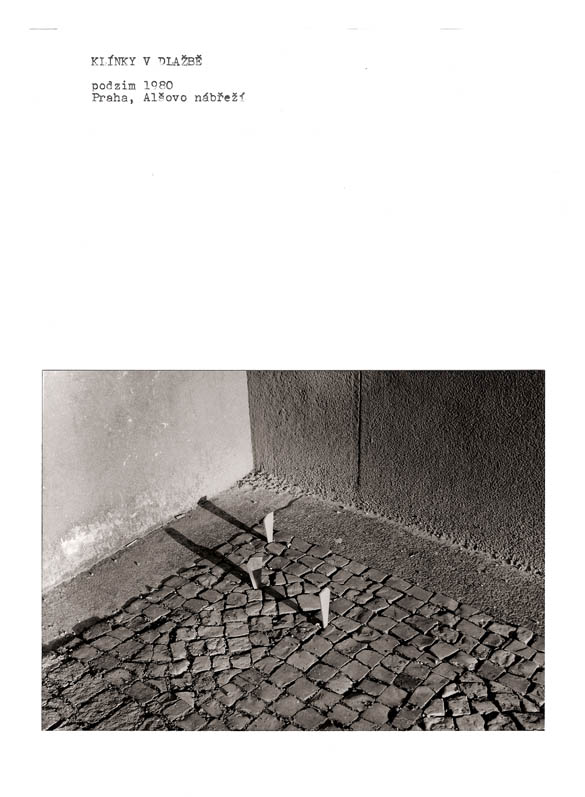
© » KADIST
Jiri Kovanda
Kovanda’s street interventions are always documented according to the same format as the actions: a piece of A4 paper, a typewritten text giving a precise location and date, and a photograph. Contrarily to the actions, he took the photographs himself. One of the rules he stuck to in his artistic practice was to always use material at his disposal, a real economy of means.

© » KADIST
Mateo Lopez
Mateo Lopez uses paper as a medium to conjure personal experiences. The artist creates drawings and trompe l’oeil objects, ranging from apples to clothing hangers to doors. These props are part of a performance; he often sets up his studio in public and uses cues from his own journeys as the inspiration for his work.

© » KADIST
Dale Harding
Dale Harding’s installation Body of Objects consists of eleven sculptural works that the artist based on imagery found at sandstone sites across Carnarvon Gorge in Central Queensland. Mouth-blown with ochre on sandstone, these extraordinary stencilled images depict weaponry, domestic tools, and ceremonial objects that are specific to the region and that relate to Harding’s own ancestry. In response to these enduring indexes of Indigenous material culture, Harding produced a suite of cast objects using the stencilled imagery as a guide, along with objects that relate to his family history: boomerangs, spears, clubs, and whips are all part of the display.
Jiri Kovanda
- location: Praha, Ceská Republika
- year born: 1953
- gender: male
- nationality: Czech
Pratchaya Phinthong
Pratchaya Phintong’s works often arise from the confrontation between different social, economic, or geographical systems...
Engel Leonardo
Working with various mediums, from sculpture to installation, site-specific interventions, and readymades, Leonardo Engel addresses issues related to the climate, nature, traditional crafts, architecture, and popular culture of the Caribbean...
Yang Xinguang
- location: Beijing, China
- year born: 1980
- gender: male
- nationality: Chinese
- home town: Hunan Province, China
Oren Pinhassi
Oren Pinhass’s practice integrates architecture and sculpture in the making of fantastical forms, employing found objects as well as replicating such objects in various media...
Zai Kuning
- year born: 1964
- gender: male
- nationality: Singaporean
- home town: Singapore
Gabriel Orozco
- location: New York City, Paris
- location: Mexico
- year born: 1962
- gender: male
- nationality: Mexican
- home town: Jalapa, Mexico
Rometti Costales
Rometti Costales is an artistic collaboration between Julia Rometti and Victor Costales that began in 2007...
Martin Creed
- location: Wakefield, United Kingdom
- year born: 1968
- gender: male
- nationality: British
Cameron Rowland
Cameron Rowland bases his practice on re-contextualizing everyday objects in ways to highlight the economic and political forces that influence our immediate surroundings, exposing dynamics that are often overlooked, hiding in plain sight...
Orion Shepherd
Orion Shepherd is a Los Angeles based artist working across drawing, collage, painting and sculpture...
Heman Chong
- year born: 1977
- gender: male
- nationality: Singaporean
- home town: Muar, Malaysia
Taiyo Kimura
Taiyo Kimura works with sculpture, video, and installation and uses everyday objects, humor, and music to questions the meaning of ordinary life...
Haegue Yang
- location: Berlin, Germany & Seoul, South Korea
- year born: 1971
- gender: female
- nationality: Korean
- home town: Seoul, South Korea
John Houck
- year born: 1977
- gender: male
- nationality: American
- home town: South Dakota
Frieda Toranzo Jaeger
Many of Frieda Toranzo Jaeger’s works take the triptych format, employed by artists over many centuries to represent religious devotion...
Dale Harding
A descendant of the Bidjara, Ghungalu, and Garingbal peoples, Dale Harding’s work references and expands upon the philosophical and spiritual touchstones of his cultural inheritance...
Marlon de Azambuja
Based on ideas of architecture, and by means of appropriation of public space and studio-based material operations, Marlon de Azambuja’s work creates new idioms for thinking and inhabiting the built environment...
Abraham Cruzvillegas
- location: Mexico
- year born: 1968
- gender: male
- nationality: Mexican
- home town: Mexico City, Mexico
Pio Abad
In his practice, Pio Abad looks into the social and political significance of objects usually consigned to the sidelines of history...
Matt Mullican
- location: Santa Monica, United States
- year born: 1951
- gender: male
- nationality: American
Sable Elyse Smith
Sable Elyse Smith is an interdisciplinary artist, writer, and educator based in New York and Richmond, Virginia...
Yuji Agematsu
Yuji Agematsu is an artist who works across various media, including sound, photography, and the arrangements of objects—not exactly sculpture...
Sarah Conaway
- location: Los Angeles, California
- year born: 1972
- gender: female
- nationality: American
- home town: York, Pennsylvania
Li Ming
- location: Beijing, China
- year born: 1979
- gender: male
- nationality: Chinese
- home town: Sichuan Province, China
Dineo Seshee Bopape
Dineo Seshee Bopape is known for her playful and experimental video works and installations of found objects...
Vaclav Pozarek
Growing up in Czechoslovakia, Vaclav Pozarek experienced political aggression, spying and ludicrous impediments...
-
1970-1979
Jiri Kovanda
1979This ephemeral installation by Jirí Kovanda, documented in the same way as his performances with a photograph and a text, belongs to a body of works that took place in his apartment/studio...
-
1980-1989
Jiri Kovanda
1980Kovanda’s street interventions are always documented according to the same format as the actions: a piece of A4 paper, a typewritten text giving a precise location and date, and a photograph...
-
1990-1999
Gabriel Orozco
1994Charco portátil congelado (Frozen Portable Puddle, 1994) is a photographic record of an installation of the same name that Gabriel Orozco made at Witte de With Center for Contemporary Art in Rotterdam for the group exhibition WATT (1994)...
-
2000-2009
Alexandre da Cunha
2005His Deck Painting I recalls the simplistic stripes of conceptual artist Daniel Buren, or the minimal lines of twentieth century abstract painting, but is in reality a readymade, fashioned from repurposed fabric of deck chairs...
Benoît Maire
2006The piece consists of sculpture of 10 elements, among them: a globe, a picture of a gorilla, a chair, scrabble letters, 3 glasses of black ink, a book whose title is illuminated by the beam of a 8mm projector, a pair of boots, etc...
John Menick
2006The theme of the end of the world, of the last man on earth, recurs in our literary and cinematographic culture and in our imaginary: “we had this dream before, the dream that we’re alone.” In The Secret Life of Things , the narrator presents himself as an enthusiast and expert on films announcing the end of the world and those staging someone waking up to discover that they are the only survivor on earth...
Marcelo Cidade
2006This series of photographs reflects Marcelo Cidade’s incessant walks or drifting through the city and his chance encounters with a certain street poetry like the Surrealists or Situationists before him...
Yang Xinguang
2009Although seemingly unadorned at first glance, Yang Xinguang’s sculptural work Phenomena (2009) employs minimalist aesthetics as a means of gesturing towards the various commonalities and conflicts between civilization and the natural world...
Heman Chong
2009With a habit of reading eight to ten books at the same time, Chong paints his two-foot tall novel covers through referencing an extensive reading list (accessible on Facebook) he has kept since 2006...
-
2010-2019
Taiyo Kimura
2010Haunted by You documents Taiyo Kimura’s struggle to use a record player, satirizing the normal actions of everyday life in order to question the meanings that underlie ordinary modes of living...
Orion Shepherd
Drawing & Print
2010(Drawing & Print) Ballad of the Unabomber Part I is a painting by Orion Shepherd that features several manila folders stacked in order according to their size, resting atop a grainy hardwood pattern...
Dineo Seshee Bopape
2012Interested in the collection of object and their potential to evoke various emotional reactions in the audience, Bopape’s “Why do you call me when you know I can’t answer the phone” is an invitation into the limitless netherworld of the unsaid and unspoken...
John Houck
2013Houck’s Peg and John was made as part of a series of photographic works that capture objects from the artist’s childhood...
Cameron Rowland
2014Rowland’s minimal installations require a focus not on the objects themselves, but on the conditions of their creation, use, and distribution...
Adriana Lara
2014Lara uses things readily at hand to create objects and situations that interrogate the processes of art and the spectrum of roles that art and artists play in society...
Oscar Tuazon
2014Oscar Tuazon‘s sculptural oeuvre is situated at the border of art, architecture and technology...
Zai Kuning
2014Justice (2014) presents viewers with a curious assemblage: a wooden gallows with slightly curved spindles protruding from the topmost plank, which in turn is covered with rudimentary netting, the threads slackly dangling like a loose spider’s web or an rib cage that’s been cracked open...
Yuji Agematsu
2015Each day, Yuji Agematsu smokes a pack of cigarettes and wanders the streets of New York City looking for trash...
Alejandro Almanza Pereda
2015This still life falls apart, or rather floats apart as the composition is proved unstable and constantly morphing...
Haegue Yang
2016A steel clothing rack adorned with turbine vents, Moroccan vintage jewelry, pinecones and knitting yarn, these heterogeneous elements are used here to create an exotic yet undefined identity within the work...
Frieda Toranzo Jaeger
2017This triptych is based on a Tesla whose interior the artist customized on the Tesla website...
Marlon de Azambuja
2017Following a series of related works, Brutalismo Americano by Marlon de Azambuja is a site-specific sculptural installation produced during the artist’s residency at Kadist, San Francisco in 2017...
Mélanie Matranga
2018My Shape (2018) is the final work of the exhibition “Sorry”, taking the form of a Levi’s denim jacket pattern, expanded three or four times larger than its original shape...
Pratchaya Phinthong
2018Untitled (Ring) consists of two prominent elements contained in water filled glass sphere...
Matt Mullican
Drawing & Print
2018(Drawing & Print) Mullican’s Stick Figure Drawings depict characters reduced to their most basic graphic representation...
Dale Harding
2018Dale Harding’s installation Body of Objects consists of eleven sculptural works that the artist based on imagery found at sandstone sites across Carnarvon Gorge in Central Queensland...
American Artist
2019From suicides, to gang violence, to the epidemic abuse of force by police departments (predominantly against Black men), to school and mass shootings, there is perhaps no more urgent issue in the United States than gun control...
Cynthia Gutiérrez
2019Estratos II by artist Cynthia Gutiérrez features a large white plinth with a transversal cut through the lower half, revealing a collection of archeological objects...
Rometti Costales
2019Canción para un fósil canoro (Song for a chanting fossil) by Rometti Costales is inspired by the history of the building that currently hosts the Museo de la Solidaridad Salvador Allende (MSSA) in Santiago, Chile...
Marina Rosenfeld
2019The installation Music Stands: Free Exercise 7, 8, and 9 by Marina Rosenfeld consists of music stand-like structures and a corresponding set of panels and acoustic devices that direct, focus, obstruct, reflect and project sound in the gallery...
-
2020-2029
Sable Elyse Smith
2020Sable Elyse Smith’s Pivot III resembles playground equipment uselessly reconfigured...
Oren Pinhassi
2020Oren Pinhassi’s work examines the relationship between the human figure and the built environment...








